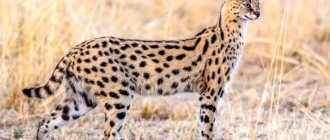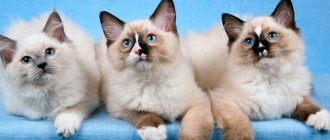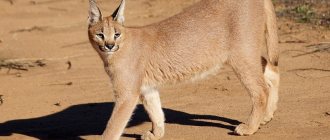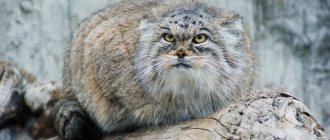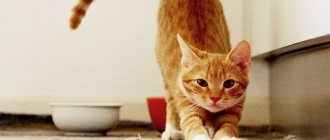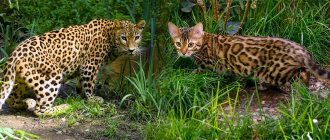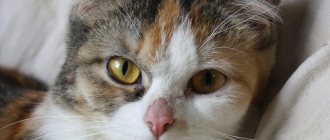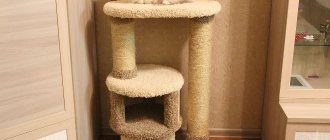7545Administration
Domestic cats are not only pets of familiar breeds. A manul cat at home is very exotic. There are people who are ready to make their furry friend a unique animal that is on the verge of extinction and, in order not to disappear from the face of the Earth, needs serious help from humans.
We are talking about a steppe cat, which is called manul or pallas. Its Latin name is felis manul, and its synonym is otocolobus (translated as “ugly ear,” although its rounded ears are not at all ugly). The description of the appearance of a powerful pallas with very thick and long fur, the size of a large domestic cat, is very attractive, but the best idea of this impressive animal is given by a photo. The wild cat Pallas is not often kept at home, but it can still become a four-legged pet. However, when deciding to get such a pet, it is necessary to take into account many of its features, since the Pallas's cat, even raised in captivity, cannot fully adapt to being kept at home and always remains a wild animal at heart.
© shutterstock
Taming and keeping Pallas's cat at home
Manul is a wild animal from the cat family.
By its nature, this creature is adapted to life only in natural conditions, and not in houses or apartments. True, the Pallas's cat can now be found in almost every zoo, and therefore many daredevils and exotic lovers decide to have one as a pet. It is important to remember that taming a wild cat is not an easy task, and sometimes simply impossible
Although the Pallas cat is a wild mammal, its size is not very different from the size of ordinary domestic cats. It weighs about 5 kilograms, and its body dimensions range from 52 to 65 cm. It is distinguished from pets by its appearance. The Pallas cat has a massive body and short thick legs. The ears are small and rounded, and the muzzle is small, but wide and flattened. The pupils in yellow eyes always remain round and do not shrink in bright light, as happens in domestic cats. The main feature of the Pallas cat (second name) is its very thick fur. Its length can even reach 7 centimeters, and there are 9 thousand hairs per square cm. The coat is usually light gray in color with small dark or yellowish spots.
Pallas' cats live in the wild nature of Asia, Transcaucasia, Mongolia or China. At the moment, the number of this species is very small, so they are listed in the Red Book. In real conditions, these cats lead a solitary life and show aggression even towards each other. Therefore, affection, love and special devotion towards a person should not be expected from them.
This species is declining very rapidly. Although zoos provide them with normal conditions for reproduction, kittens often die from infections. And adult individuals do not always take root, let alone their life in apartments. If it does happen that this predator lives in the house with people, then they need to be prepared for his difficult temperament. The character of the Pallas cat is very unpredictable; he can easily damage household property, break all the vases and tear up furniture or curtains.
Another big disadvantage is the incredibly thick and long fur of the Pallas's cat. It will be very difficult to care for her, and it is necessary to take into account the fact that all cats shed, even wild ones. This is a predatory animal with sharp fangs and claws. Therefore, the consequences of an attack will be several times worse than from an ordinary pet.
Still, many lovers of cats or unusual animals, despite all the difficulties, agree to tame and keep Pallas's cat at home. Of course, this should be done not with an adult, but with a small kitten. Then the chances that he will not grow up to be very aggressive become higher. But to a greater extent, everything simply depends on luck, because each wild cat has its own character. Even if he lives with a person from birth, he still does not become affectionate and devoted. There have been cases when a Pallas cat was fed by an ordinary domestic cat. But even then he did not adopt her habits.
Do not forget that it is simply impossible to legally purchase and tame a Pallas cat kitten. After all, the species is on the verge of extinction, and therefore keeping them in the wrong conditions is illegal. If Pallas’s cat is somehow acquired, then many difficulties and problems immediately arise:
Features of life in the wild
Most often, Pallas' cats live in the steppe zone, in semi-deserts, and can also inhabit mountainous areas. Places of residence - caves, rock crevices, abandoned holes of other animals, under stones. The main thing is that they have a shelter hidden from human eyes. Since it is man who is the main enemy of the manul cat. Therefore, you will never see them near human settlements; they carefully avoid getting close to people for the sake of caution.
These animals live alone. They lead a nocturnal lifestyle - they spend daylight hours in their home, and at nightfall they go out in search of food.
In nature there are three subspecies of Pallas's cat:
- Siberian - with a light gray color, lives in Mongolia, China, and also in Siberia;
- Tibetan - with a silver color in winter and dark in the rest of the year, lives in Nepal, Tibet, Pakistan, India, Kazakhstan, Kyrgyzstan, Uzbekistan, Tajikistan;
- Central Asian - with a red color, lives in the countries of Central Asia.
In the Russian Federation, the Pallas' cat is listed in the Red Book. In some countries it is classified as an animal that is close to extinction. This wild cat is featured on rare animal stamps issued by the United Nations.
The extinction of the species is associated with human activity. Most often, Pallas' cats die in traps that are set for other animals, or they are killed for their fur. Their enemies are also feral dogs, wolves, and birds of prey.
Due to their secretive lifestyle, it is quite difficult to keep track of the number of individuals that live on Earth. About 150 Pallas' cats now live in 50 zoos around the world.
Important! Buy Pallas's cat only with documents from legal sources. Remember that by buying an animal from private hands, you support poaching and become accomplices of lawbreakers.
Description of the animal
Unlike other wild representatives of the cat family, sand cats are characterized by their smallest size and rather original appearance.
Appearance
The average body length of an adult varies between 65–90 cm, of which about 40% is the tail. The maximum height of the sand dune cat at the withers is no more than 24–30 cm. Males are slightly larger than females, but their body weight does not exceed 2.1–3.4 kg.
The sand cat is the smallest predator cat living in natural conditions.
The predatory mammal has a large and wide, noticeably flattened head with sideburns. Large and wide ears are completely devoid of tufts. The eyes are characterized by a yellow iris and slit-like pupils.
The dune cat has short and fairly strong, well-developed paws, and the feet are covered with coarse hair that protects the pads on the paws from burns when moving along the hot sand in the sun. The fur of the sand cat is thick and soft, so it can perfectly protect the body of a predatory mammal from low temperature exposure at night and overheating on hot days.
Color
The color of a cat's coat can range from sandy to light gray. On the back and tail you can see gray-brown stripes, which often blend in with the overall fur shade or look darker than it. There is a darker, more pronounced pattern on the head and paws. The tip of the animal's tail is dark, and on the chest and chin the fur is lighter than in other places. In the cold season, seals living in Central Asia grow a thicker coat, which has a dull sandy tint with a grayish coating.
The color of the animal helps it remain invisible among the sands and stones
Character
This pussy is characterized by modesty and secrecy. When moving to a new territory, it hides even during the day. In this regard, naturalist photographers look for the cat at night. The migration of an animal is a quiet process. If, nevertheless, a person manages to see a dune cat, then the latter freezes in place with his eyes closed so that their shine does not give away the animal. But during the hunt, the cat acts quickly and leaves no marks on the sandy surface. The speed of the animal can reach 40 km/h.
During the hunt, the sand cat moves quickly, leaving no traces on the sand.
Nutrition
It is common for this breed of cat to pull porcupines and lizards right out of the sand. Seals have an interesting ear structure and good hearing, so they pick up every rustle underground. Thanks to its whiskers, the animal senses slight vibrations in the air and follows the trail of a nest with chicks. In general, he tends to eat almost any prey that he manages to catch:
- gophers and gerbils;
- jerboas;
- monitor lizards and geckos;
- small birds with chicks;
- small hares;
- insects
Traditional dry or wet food intended for feeding domestic cats is strictly not recommended. In captivity, the sand seal can be fed the following fresh foods:
- poultry meat;
- beef;
- fish;
- a house mouse, if it is possible for the cat to catch it.
Photo gallery: foods that can be fed to a sand cat in captivity
Reproduction
At 9–14 months the animal matures for mating, which occurs once a year. Cats become pregnant in mid-winter, and give birth in early spring. Animals living in zoos have the opportunity to give birth more often, since it is easier for them to survive in captivity and all the animals’ energy is spent on procreation. During mating season, males and females make barking sounds.
A month after birth, kittens begin to hunt on their own.
A pregnant cat is looking for a den for her offspring. If she doesn’t find anything suitable, she digs a hole on her own. A cat can give birth to 4–8 kittens at the same time. 2 weeks after birth, the cubs’ eyes open, and a month later the babies go hunting for the first time. In captivity, seals live 10–11 years, but there is no exact figure due to the secretive lifestyle of these animals.
Caring for Pallas cats
Pallas's cat (Felis manul or Otocolobus manul) is a wild animal belonging to the cat family and the subfamily of small cats. Its habitat is limited to Central and Central Asia. You can often find its other names - steppe cat, cave cat, Pallas's cat.
Thanks to its long and fluffy fur, it seems that the Pallas's cat is very large. In fact, its dimensions are: length - 52-65 cm, body weight - 2-5 kg. Tail length is from 23 to 31 cm.
Did you know? Pallas's cat has the thickest fur coat among cats - there are about nine thousand hairs per square centimeter of skin. Each of them can be up to 7 cm long.
The eyes are yellow. Their distinctive feature is that in bright light the pupils do not change their shape; they remain round, unlike domestic cats, in which they take the shape of a slit.
The fangs of a wild animal are three times longer than those of a domestic cat. The cheeks are covered with long hair forming sideburns. The Pallas' cat's tail is long and thick, rounded at the end.
The fur of a cave cat is gray with a reddish tint. The tips of the hairs are white, so it seems that the animal is covered with snow. There are transverse dark stripes on the back. There are dark spots on the top of the head. The end of the tail is painted black.
Males are usually somewhat larger than females. There are no other external differences between them. In the wild, Pallas' cats live on average 10-12 years. In captivity they can live a little longer. Thus, in zoo conditions, some individuals lived up to 20 years.
While exploring the Caspian steppes, a scientist named Peter Pallas was very surprised by such an incredible find. After all, he is the lucky one who saw the Pallas's cat first.
The ears of this representative of the cat family are indeed quite original in appearance, but are they so ugly? Most likely, the scientists were in a hurry with the name. There is another name for the Pallas cat - Pallas's cat.
The fluffy and beautiful fur of the Pallas cat brought him a lot of trouble: these cats were actively exterminated. Today the Pallas's cat is under protection, its photo is in the Red Book. You cannot hunt these cats.
In general, this cat breed has quite a few differences from the most common domestic cats. The length of the Pallas's body and tail, the shape of the skull and everything else is very similar to the classic cat standards common among pets. But the obvious difference is the length of the paws - they are short, and because of the very fluffy fur coat of the Pallas's cat, the limbs look plump, however, this can be said about the entire animal as a whole. The average weight of a Pallas's cat is about five kilograms.
This cat has very soft fur, it is long, fluffy and silky to the touch. Scientists say that approximately nine thousand hairs grow on one square meter of the Pallas's body. The fur of the Pallas's cat is light gray, and the tips are light. The tail usually has dark horizontal circles.
The tail itself is gray, with a black rounded tip. There are lighter hairs on the tips of this cat's ears. The cheeks are also covered with black stripes, most often there are two of them. There are similar patterns all over the body. The lower body of the animal is brown with light spots.
Since in the steppe area the weather is almost always windy, and the air temperature is most often high, the eyes of the Pallas's cat are developed in such a way that it constantly blinks - this way the eyes do not dry out. Although these animals live in natural conditions, their claws are not sharpened, but on the contrary, they are long and sharp.
In the wild, such an animal can live for approximately ten years, but in captivity, Pallas's cats often reach twenty years of age.
The size of the Pallas' cat is similar to that of ordinary cats, but its appearance is quite massive. It is worth saying that in reality these animals weigh half as much as ordinary domestic Maine Coons.
Animal standard:
- strong body;
- somewhat flat muzzle;
- gray wool with light tips;
- black stripes on the tail and body, the tail is black;
- lightened tips of the ears;
- two black stripes on the cheeks;
- large yellow eyes with unusual pupils.
Cat breeds
Today there are three varieties of Pallas's cat breeds known. They don't have any special differences from each other. Their body size does not differ, but there is a slight difference in the color of the coat.
Simple manul
As mentioned above, the coat color of the common Pallas's cat is light gray; this animal usually lives in the steppes of Mongolia, Siberia and China. At the end of the eighteenth century, this cat shocked the whole world with its appearance.
Life in captivity
The Pallas's cat is completely unsuitable for life in captivity, so keeping it as a pet will not work. Difficulties with adaptation also arise in animals that end up in zoos. Due to severe acclimatization, the manul withers away, the protective functions of the immune system decrease, and the cat begins to get sick often.
After completing acclimatization, the Pallas's cat begins to feel freer in the zoo and quickly gets used to the enclosure allocated to it, which zealously protects it from the encroachments of other animals. In captivity, if conditions are created for him that are as close as possible to natural ones, the Pallas's cat continues to lead an active life, hunting game, which is its usual diet.
Kittens from a litter that are born in captivity have very weak immunity, often get sick for a long time, many of them live no more than 10-15 months.
Features of keeping a manula as a pet
Warnings not to keep a Pallas's cat as a pet have reasoned explanations. The representative of this cat world is absolutely wild and unadapted to life in society.
Even if you take home a very baby cat, he will not grow up grateful and affectionate, and will quickly forget about who fed him. Owners should expect outbreaks of aggression in their direction, as well as the fact that the cat will lunge at them and scratch them.
But, despite such negativity towards household members, manul is a breed of cats that have a calm and friendly character, and their aggressiveness is caused solely by their reluctance to be in captivity.
The manul in the apartment is like a pet; there are torn curtains, clothes and completely damaged furniture. In addition, the owners will spend nights without sleep, because the animal hunts, and does this mainly in the dark.
The owners will quickly fall out of love with the fluffy fur of the Pallas's cat, as it will constantly and actively shed. In this case, wool will be everywhere without exception, from clothing to cutlery.
The absence of constant snow, in which the Pallas's cat is used to caring for its coat, must be compensated by frequent water treatments and endless combing of its thick and lush coat.
If you want to have such an unusual cat, you should provide him with a vast local area, where he will feel much more comfortable than in an apartment. After all, Pallas' cats prefer solitude to society and, outside of hunting, spend time in solitude in their hole.
Nutrition
In conditions of captivity (living in an apartment/house), the Pallas's cat must be provided with its usual diet. The menu should include fresh and lean meat and fish, and the cat should regularly receive greens and berries. Pallas' cat consumption of industrial dry and wet food is unacceptable.
- fluffy cat breeds;
- the most beautiful cat breeds;
- most popular cat breeds.
Description
Outwardly, the Pallas's cat looks almost the same as an ordinary cat, but it has a denser body and thicker hair. Body length 50-65 cm, tail length 23-30 cm, weight 2-5 kg. The head is medium-sized, wide, the ears are round and small. The eyes are yellow, with round pupils that do not change even in bright light. On the cheeks there are elongated hairs – sideburns.
The coat color of the Pallas's cat is light gray with fawn and ocher shades, the hairs have white tips, which gives the impression that the cat is dusted with frost. In general, the animal’s fur is beautiful and valuable, so it has been the object of hunting for a long time. It was exterminated until it became an endangered species and was included in the Red Book of Russia. Currently, the wild cat is protected by law. This suggests that it is impossible to legally purchase a Pallas cat in our country.
Breed Features
Outwardly, the manul is almost indistinguishable from a domestic cat. A medium-sized cat weighs about 4 kg. The illusion of the large size of the animal is created due to the abundant growth of fur.
For comparison: the popular Maine Coon is at least 2 times larger than the Pallas cat; The wool density of Merino sheep is 8800 hairs per 1 square meter. cm, for Pallas's cat this figure is 9000.
The animal's body is dense and muscular, its legs are short, and its tail is voluminous. The seemingly discolored tips of the hairs serve as camouflage during winter hunting.
The flat face and rounded shape of the ears suggest that Pallas cats are related to Persian cats. The animal's eyes are designed to prevent drying out: nictitating membranes ensure frequent blinking.
At the moment, scientists identify several varieties of Pallas's cat - all their differences largely come down to one or another coat color.
Table 1. Types of Pallas's cats
Video - Manul: all about the unusual breed of cats
Reproduction of Pallas's cat
The only reason when these hermit cats, Pallas's cats, do get together is for procreation. Their mating season begins in late February - early March, at which time males begin to look for a mate for mating.
It’s funny that just before “this thing” itself, males can gallantly court their tailed “lady” - throw food gifts at her paws and ferociously drive away other potential competitors. However, courtship does not last long, due to the short estrus in females, males need to have time to conceive children within a few days, if this does not happen, then pregnancy can no longer be expected this year.
Having done the job, the males leave, leaving all worries about the future kittens to the female. The pregnancy of a Pallas cat lasts 60 days; towards the end of this period, she looks for a secluded place where blind and helpless kittens are born. From 2 to 6 kittens are born at a time.
Pallas cat kittens weigh only 200-300 grams at birth. They are completely helpless and are under the full care of their mother. The mother manul takes care of her babies, feeds them with her breast milk, teaches them to walk, hide, and then hunt. By the way, manula kittens go on their first hunt by the age of 3 months, and at the 10th month of life they become sexually mature adult cats, after which they leave their mother.
Despite the fact that the Pallas' cat is extremely difficult to tame, there are exotic lovers who still risk getting a pet Pallas's cat. This is exactly what is at risk, since at home the Pallas's cat will behave wildly and unpredictably; if you try to pet it, it can easily scratch or bite. And you should definitely prepare for scratched furniture and torn wallpaper.
Also, the immunity of Pallas's cats kept in captivity deteriorates, they often begin to get sick, as if their very nature protests and demands a return to their native and wild steppes. Therefore, we highly recommend not keeping Pallas's cat at home.
How to buy and price
Purchasing a manul is quite an expensive pleasure. If we consider the question of how much a Pallas cat costs, then the price for a small kitten can start from $10,000, taking into account the fact that the animal is almost impossible to domesticate. It is also quite problematic with the legal acquisition of this breed, and not only in Russia. There are simply no nurseries engaged in breeding these predators in the CIS.
When deciding to place such a predator in your home, you need to really weigh all the advantages and disadvantages of this pet. No matter how outwardly beautiful this wild cat may be, he will always remain a wild and untamed animal; for him, a person is not the owner, he is just an ordinary companion.
Reproduction
The breeding season for Pallas' cats in the wild is February-March. Females bear kittens for 74-75 days, the offspring are born in April-May. The litter size is 2-10 kittens, with an average of 3-5. Pallas' cat cubs are born blind and helpless, weighing 300-400 g, 10-12 cm long. The female is responsible for raising them entirely. At 2 months, kittens shed their hair and weigh 500-600 g. At the age of 6-8 months they reach the size of an adult animal.
As for breeding manuls at home, this is possible, but rarely practiced. Those who have tried to breed wild cats note that Pallas cat kittens are not much different from kittens of domestic breeds - they are just as affectionate and funny. But during puberty, cute kittens turn into demons and begin to terrorize family members.
Manul is not a domestic cat. Let us give as an example the story of one Pallas's cat, who now lives in a zoo, and before that “delighted” one Moscow family with his evil rumbling. The cute cat has grown up and taken a dominant position in the house. The family was afraid to move around the apartment, because the cat was waiting for them at every corner and rushed to bite.
In fact, this is typical behavior for Pallas cats. Up to a certain age, they are like angels in the flesh, but soon they change their behavior to the exact opposite, so much so that it’s time to call an exorcist. Still, nature takes its toll. Pallas' cats are clearly not intended for pets.
Price
The wild popularity of the Pallas's cat made him not only the hero of memes and the king of the Runet, but also prompted many connoisseurs of the species to look for places of sale. On thematic forums, some sellers quote prices of tens of thousands of US dollars. And this despite the fact that cats are listed in the Red Book, and their trade is punishable by law.
Anyone who dreams of buying a Pallas's cat should know that cats cannot be tamed; they are not in the mood for human contact. At best, they simply tolerate the presence of others. Animals respond to an invasion of personal space in two ways - either they ignore the intruder, or they use claws and fangs, the length of which is three times longer than that of an ordinary cat.
Tamed manul
It is not for nothing that the Pallas cat is considered an exotic animal. It will not be possible to completely tame him. Therefore, even if you bought him as a small child, you should not count on him becoming a tame kitten. The instinctive isolation of the Pallas's cat from humans will be inherent in it even when kept at home. And even if at a young age a kitten is still able to play with human hands, then after puberty this will no longer be possible, instincts will take over.
Increasingly, exotic animals are chosen as pets: lemurs, raccoons, salamanders, crocodiles, leopard geckos, snails, iguanas, chameleons, squirrels, jerboas.
Conditions for keeping
Of course, the best place to keep such a pet would be a private yard. The cat can withstand low temperatures, and the open space, trees and bushes will remind him of his natural habitat. In addition, in the yard it will be more comfortable for him to lead a nocturnal lifestyle and not disturb the owners.
He is absolutely not suitable for keeping in an apartment, since it is unlikely that it will be possible to provide him with conditions where he can hide and where he will not cause inconvenience when he goes out hunting at night. In addition, you must always remember that entering its territory is taboo for a person; he risks getting bitten and scratched.
Important! Despite its slowness, the wild cat has lightning-fast reactions and can attack an enemy without warning. His dissatisfaction will not be revealed by any external manifestations, because his muzzle always has an angry and wary expression.
Breed care
Like any wild animal, the manul is capable of caring for itself. It is unlikely that you will be able to accustom him to forced water procedures. The only thing you can try in terms of grooming is combing out the animal’s fur, which is almost constantly in a state of shedding. Owners of Pallas cats in their apartments feel this well, finding clumps of cat hair throughout their home every day.
What to feed a wild cat
What to feed the animal is one of the first questions that a person who is planning to get a Pallas's cat should ask himself. In the wild, this feline feeds on the Daurian pika and small rodents. As a rule, it watches for them, hiding near their holes. It can also hunt hares, marmots, and birds. If food is tight, it eats insects.
Whether you can provide your pet with such food is up to you to decide. After all, there are big doubts that a wild animal will want to eat dry cat food or canned food. At the zoo they are fed meat and rodents.
Did you know? Manul was first discovered in the 18th century by naturalist Peter Simon on the shores of the Caspian Sea. It was named Otocolobus, meaning "ugly ear".
Lifestyle
Wild cats lead a solitary, sedentary lifestyle. They prefer to settle in rocky areas (hence another name - cave cat). Pallas' cats make dens in stone crevices; with their sharp claws they can dig a hole for their own housing. The animals carefully guard their home and drive away any stranger who looks there.
The love for rocky terrain and cold winters with little snow determine the range of animals: Tibet, Western China, Transbaikalia, Mongolia, Afghanistan.
Pallas' cats prefer a nocturnal lifestyle: they hunt only in the dark.
Pallas cats are considered the first cats to appear in the world.
The prey of wild cats are mice, small hares, small birds, and marmots. Nature has not blessed cats with quickness, so they can wait for hours for future food near their holes. In summer, insects and plants are added to the diet. All because of the same slowness, manulas themselves become the subject of hunting by larger predators. These felines cannot escape; when in danger, they hide or climb a tree.
In mating games, Pallas' cats do not differ from their domestic relatives: several males fight for the location of one female and start fights.
Pallas's cat in the wild
The predilection for loneliness makes it difficult for wild cats to reproduce: it is difficult for them to find a mate. By the way, this is one of the reasons why Pallas' cats are constantly on the verge of extinction. Other factors contributing to the population decline: poaching, the risk of falling into a trap set for other animals, eating small rodents poisoned by chemicals, and death in forest fires.
There are usually 2-6 kittens in a litter; in the first 2 months of life they are helpless; only the female cares for the cubs. Growing up, babies begin to leave the shelter, adopt the hunting habits of their mother, and reach full independence by 8 months.
In captivity, animals reproduce poorly, even in a zoo. Employees note that captured females who grew up in the wild experience pregnancy more easily and raise offspring safely. Of all the kittens born in captivity, no more than half survive.
Manul with kittens
Like other predators, Pallas cats have acute vision and hearing.
Interesting facts about Pallas' cat
Difficulties of home maintenance
Keeping wild cats as pets is not easy and is not always justified. Having decided to have a Pallas's cat at home, you need to be prepared for a number of difficulties that will arise in such a neighborhood. This wild cat is self-sufficient, and therefore it does not need people or other animals at all, with the exception of rodents, which the manul loves to hunt. Manul is not the affectionate domestic cat that everyone is used to; and he will not sit on his lap, enjoying communication with his master. Keeping Pallas cats at home is associated with serious problems.
Aggressive behavior towards children if they become overly persistent in pestering the animal, imposing their communication on it and especially trying to remove it from the chosen den. These are not your typical domestic cats. Damage to everything around. Pallas' cats are similar to teenage puppies, who tend to damage furniture and shoes by chewing them. The cat will happily try many things, and will also constantly scratch furniture, walls, curtains and even linoleum. Due to the special strength of the teeth and paws, the damage caused by a Pallas's cat living at home is very significant. Having settled an animal, you need to remove expensive things from its access area. Pallas' cats are not domestic cats that respect their owner. Treatment problems
Due to the behavior of a wild cat, if it has health problems, you may not immediately pay attention to them. Also, due to the fact that the animal is wary of people, it will be quite difficult for a veterinarian to examine it properly.
An additional problem will be the fact that there are few specialists who know the characteristics of these animals. Therefore, treatment for Pallas cats will most likely be carried out in a similar way to what domestic cats receive, but this is not true. Constant shedding. The manul has particularly thick hair up to 7 cm long. The cat sheds very rapidly in the autumn and spring. During the rest of the year, the Pallas' cat's fur is actively replaced, and therefore shreds of it will always be present in the apartment. In order to reduce the contamination of your apartment with fur, you need to regularly brush your exotic pet, which is extremely difficult if it is too wild. Domestic cats shed 2 times a year. Hunting instinct. The cat is strong and perfectly adapted for hunting not only small rodents, but also marmots, which is why it can pose a danger to small pets, including puppies and small breed dogs, which the pet may decide to feast on as if it were fresh game. .
shutterstock
If a pair of Pallas cats is purchased in order to start breeding them at home, this decision can be called a mistake. In apartment conditions, it is almost impossible to get offspring from animals. The cat and cat will constantly compete with each other for territory and the best places for privacy.
When planning to place a Pallas's cat in your home, you should soberly weigh all the pros and cons of such a pet. No matter how attractive this steppe cat may be in appearance, it always remains a wild animal, for which a person cannot be not only an owner, but also just a companion. Domestic cats accept their owner as a companion.
When settling this steppe predator in your home, it is important to remember that, even when raised from a kitten, a pallas cannot be called completely tame. Manulas are not domestic cats
The animal does not change its freedom-loving nature in the comfort of home, and always strives to return to its natural life. Choosing a manula instead of a domestic cat is a rather original solution.
Character and habits
Lonely lifestyle
They are found only during mating games, when males actively compete for the attention of the female. In other periods they prefer not to contact their own kind. Activity begins at dusk and after sunset, mostly sleeps during the day
In warm weather, it can bask in the sun, but this is rather an exception to the general daily routine. It makes its lair in rock crevices, caves (hence another name - cave cat), under stones and in old burrows of foxes and badgers. Pallas' cats are characterized as the slowest and most clumsy representatives of the cat family. They are not adapted to running fast, covering long distances, or even deftly climbing trees. Mom raises her kids quite strictly. If the kittens are very capricious, they may even bite the scruff of the neck or give a blow with their paw. At home, the Pallas's cat shows its wild temperament and can be aggressive towards its owners and other pets. That is why taming a Pallas cat is an extremely difficult task with very modest chances of success.
The manul cat is not able to run fast, so in case of danger it prefers to hide among the stones. It is impossible to tame the Pallas's cat due to its rather angry and aggressive nature. Even Pallas cat kittens raised at home become wild with age.
Interesting: Pallas's cats cannot purr even in childhood! They communicate with each other using rude screams, and when meeting an enemy they emit a threatening hiss.
Pallas's cat can be called a real loner, a steppe warrior.
The manul cat, whose photo is now so numerous on the Internet, has a difficult character; it is difficult for him to get along even with his own relatives.
In essence, these cute animals with always a serious expression on their faces are true lovers of solitude.
Pallas' cats hunt at night, as is customary with most predatory animals. Although, a Pallas cat who went hunting early in the morning or late in the evening is also not such an exception to the rule.
They like to walk during the daytime, especially when it comes to the spring or summer season. They, like all cats, love to bask in the sun.
The Pallas cat does almost everything in his life leisurely, without unnecessary haste. They stalk the future victim with dignity and calm, and then overtake it from an ambush. It is convenient for them to track prey right next to its burrow. Wild Pallas' cats have an excellent reaction, which gives them the opportunity to successfully hunt and get their own food.
Sensing danger, the Pallas cat will immediately hide; in rare cases, it happens that he immediately tries to hide in cover. However, the manul is not a helpless animal, although it may seem otherwise. He knows how to emit a menacing roar and also attack the offender.
Pallas cat cats cannot purr. It is very rare to hear even the usual cat meow from them. When communicating with relatives, they make rude sounds similar to the exclamation “wow”. Having met an offender, the manul cat will growl and hiss.
Content issues
There are only a few known cases when Manul behaved adequately at home. Usually a wild animal does not accept its owner, so it secludes itself or causes a pogrom.
The complexity of the content lies not only in its behavior, but also in its physiological characteristics. The cat sheds a lot because an apartment is not his habitat. Eating problems may also arise. In the wild, the predator feeds on rodents and small mammals, obtaining a sufficient amount of useful substances naturally. In order for the patient to feel comfortable, it is necessary to create a balanced diet for him.
As for the continuation of offspring, it will be almost impossible to find a mate for such a rare pet, and they cannot be castrated or sterilized. In the spring, Manul will “demand” mating, and it is unknown how hormonal disruption will affect his behavior.
Most veterinarians will not be able to treat an exotic pet in case of illness due to insufficient qualifications.
What affects the cost of a British kitten
- The main reason influencing the price of a British kitten is its class. Show class cats are recognized as the most expensive and elite. For one small lump they ask for 15-30 thousand rubles, focusing on age, gender, pedigree, color.
- British breeding class kittens are sold a little cheaper. The price for these pets ranges from 9-15 thousand rubles.
- The most budget option will be the British pet class. A good kitten of this class costs between 3-6 thousand rubles. This cat will make a wonderful pet, but he will definitely need to be spayed/neutered.
- At a reasonable price, it is possible to purchase a purr without documents. Among their representatives there are British, which basically correspond to the breed standards, and those that only partially resemble them.
Not everyone knows how much you can buy a fold-eared kitten from a breeder. Many people want to save money, and in the hope that they will be lucky with a pet, they take a kitten from their hands on a website on the Internet, a bird market, or through an advertisement in a newspaper. However, some later regret it, because the kitten is growing, and it is not a fact that it will correspond to its breed. Flaws in the structure of the body, color, etc. are not excluded. But it is not yet known what kind of character the pet will have?!
Where does the manul live?
Pallas's cat lives in the steppes of Central Asia. It can be found in the following countries:
- Kazakhstan
- Tajikistan
- Kyrgyzstan
- Iran
- Afghanistan
- Pakistan
- Nepal
- India
- Butane
- Mongolia
- China
- Russia
In Russia, the Pallas's cat lives in the Trans-Baikal Territory, Chita, Altai, the Republic of Tyva and Buryatia. The animal is found in western China. Previously, Pallas's cat also lived in Armenia and Azerbaijan (in 2017 it was seen in the Zangezur National Park of Azerbaijan), but according to data for 2022, the populations in these countries have been almost completely exterminated.
As a habitat, the Pallas's cat prefers open steppe spaces with low snow cover in winter and a sharply continental climate. It is found in the highlands at an altitude of up to 4,000 meters above sea level - in rocky crevices, rocky outcrops, semi-desert areas of mountains and bush thickets. Practically does not live in forests and lowlands.
